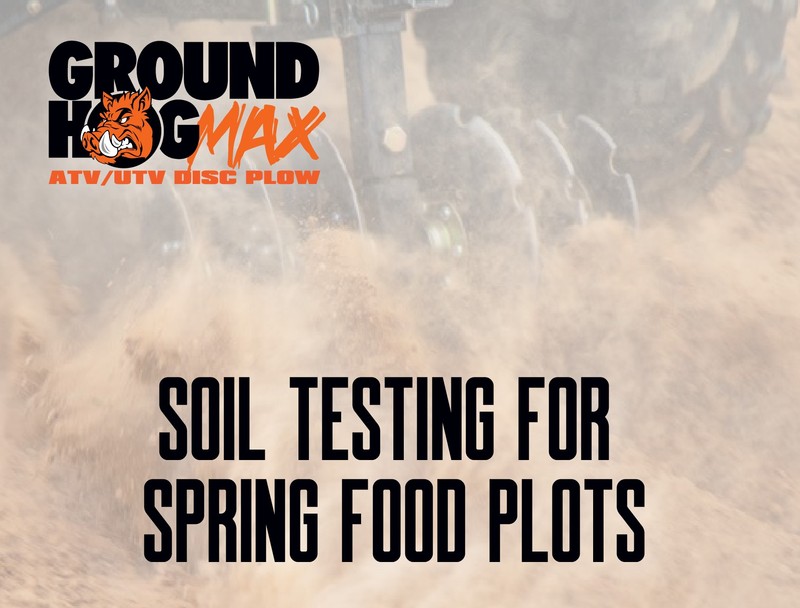Soil Testing for Spring Food Plots
Spring food plot preparation with your GroundHog MAX is just around the corner. Now is the time to have your soil tested to ensure the best results. If you're new to soil testing, here are a few tips to get started.
WHERE TO TEST
Once you’ve decided where to put your food plots, pull some soil samples from each area to be planted and send them to a soil-testing lab for analysis. A soil test determines how much lime and fertilizer is needed to grow a specific crop to its maximum potential. Soil tests should be done at least every two years since tremendous amounts of nutrients are removed from the soil each year by growing plants and leaching due to rain.
HOW TO TEST
Taking a soil sample is simple—the only things you need are a shovel or soil probe, a clean bucket, and boxes or bags to ship the samples. Boxes often are available at no cost from your county extension office or at many feed and seed stores. Using the shovel or soil probe, take the sample from the top six inches of soil in each food plot. This is where the roots of the crops will grow. Make sure the sample is free of grass and other vegetation as this added material affects the test results.
On small food plots of 1/2 acre or less, you can take the sample from one spot in the food plot. Place approximately 1-1/2 to 2 cups of the soil in a container suitable for shipping to the soil-testing lab. Label the sample with the name of the food plot and the crop to be planted. If samples from multiple locations are submitted without their locations labeled, the lab will not be able to match test results with the source food plot. Each crop has a different pH level and nutrient requirements, so make sure the crops to be planted are indicated on the container to ensure the correct recommendations.
WHAT DOES IT COST?
Check first with your county extension office as many states offer free soil testing. Otherwise, most soil testing labs charge a small fee, usually less than $10 per sample; however, some of the larger feed and seed stores provide free or reduced cost soil tests to their customers. Regardless of the costs, taking soil samples and getting soil tests for each food plot are two of the most cost efficient things that can be done prior to planting. Knowing exactly how much lime and fertilizer to apply maximizes the productivity of each food plot, which saves money in the long run.
HOW TO INTERPRET SOIL TEST RESULTS
Once soil test results are received, they usually come with details as to what your soil needs. Test results provide recommendations such as tons of limestone per acre and pounds of nitrogen (N), phosphorus (P) and potash (K) per acre. For many people, the confusion comes from the recommendations and the way fertilizers are labeled. Commercial fertilizers are labeled to indicate the percentage of N (first number), P (second number), and K (third number) in each bag of fertilizer. A 50 lb. bag of 13-13-13 fertilizer contains 6.5 lbs. of N, 6.5 lbs. of P, and 6.5 lbs. of K. On the other hand, soil test results give recommendations as pounds per acre. Farmers' co-ops and most seed and fertilizer dealers can provide further assistance with interpretation of soil test results.
LIME AND FERTILIZER
To get the most production from a crop, follow the lime and fertilizer recommendations exactly. Skimping on lime and fertilizer results in wasted money and crops that do not produce to their potential. Of the two, the most benefit is gained from adding the recommended amount of lime to raise the soil pH to the desired level. Having the soil pH in the optimum 6.5 to 7.0 range enables plants to utilize a much larger percentage of the available soil nutrients than when the soil pH is more acidic or basic.
Apply lime well in advance of planting—preferably three to six months to give the lime adequate time to affect the soil's chemistry and increase the soil pH. Limestone can be applied to either plowed or unplowed food plots, but plowing it in after application enables it to work faster. Other sources of lime, such as hydrated lime or pelletized lime, are also available for correcting soil pH.
Apply fertilizer at the time of planting. Fertilizer is easily applied with a spin-type seed/fertilizer spreader, which allows better control of fertilizer distribution than the buggy and generally works best on average-sized food plots.
THE GROUNDHOG MAX
Next month we will look at how to best use your GroundHog MAX when preparing spring food plots. Knowing what your soil needs and having the necessary ingredients ready to incorporate into your soil when plowing is key.
For purchasing information or to shop other UTV accessories, visit Bad Dawg Accessories.

